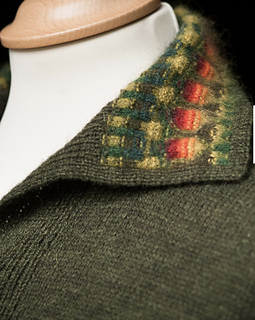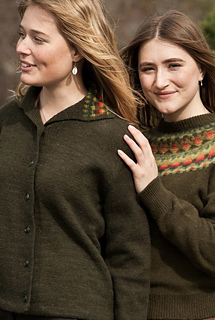patterns >  AngoraGarnet
AngoraGarnet
> The Wild Apple Jacket





The Wild Apple Jacket
“Vildäpplet” (The Wild Apple) was designed for Bohus Stickning by Kerstin Olsson in 1958.
Vildäpplet was one of Kerstin Olsson’s first patterns as a designer for Bohus Stickning and she was inspired by a rowan tree she saw outside a window of Bohus Knitting’s premises at Guldheden, Göteborg.
The pattern for Vildäpplet is, as is typical of Bohus Stickning, a combination of knit and purl stitches that create a three-dimensional pattern like little pearls in the pattern. As one of Kerstin Olsson’s first designs, she did not reflect much on how technically difficult the pattern would be to knit for Bohus Knitting’s knitters. The pattern has 13 pattern colors and is knitted with up to four pattern colors at the same time.
The knitting kit for Vildäpplet was developed in consultation with Kerstin Olsson using original patterns and models from museum collections. Vildäpplet was recreated by Solveig Gustafsson in 2007 and revised by Pernille Silfverberg/AngoraGarnet in 2016.
Vildäpplet is available as a pullover/cardigan, jacket with a patterned collar, hat, tam, and triangular scarf.
For the Vildäpplet jacket with a patterned collar, the pattern is knitted in a two-strand angora yarn in 50% angora and 50% merino wool spun at Henrichsens Uldspinderi in Denmark. The angora wool is cut by hand and is from AngoraGarnet’s own angora rabbits. The merino wool is from New Zealand and is guaranteed mulesing-free. The bottom of the jacket is knitted in stockinette stitch in dark green lambswool yarn that is dyed at the spinning mill to achieve even coloring. With few exceptions, the pattern yarns are dyed by Pernille Silfverberg by hand.
The original garment buttons were mother-of-pearl 12 mm in diameter with two holes and a small notch between them. Buttons are not included in the knitting kit. The jacket is knit from the bottom up and has set in sleeves.
There is a pattern for a version of this garment in the book Poems of Color, however it uses different yarns and a gauge much larger than the original.
453 projects
stashed
429 times
51 projects
stashed
25 times
- First published: January 1958
- Page created: April 15, 2023
- Last updated: April 15, 2023 …
- visits in the last 24 hours
- visitors right now




